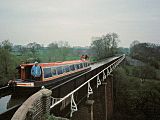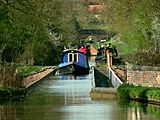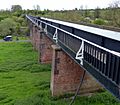Edstone Aqueduct facts for kids
The Edstone Aqueduct is a special bridge that carries water for boats! It's one of three amazing aqueducts along a 4-mile (6.4 km) stretch of the Stratford-upon-Avon Canal in Warwickshire, England. What makes these aqueducts unique is that the paths next to the canal, called towpaths (where horses used to pull boats), are at the same level as the canal water itself.
At 475 feet (145 meters) long, the Edstone Aqueduct is the longest bridge made of cast iron (a very strong type of metal) in all of England that carries a canal. It crosses over a small road, a railway line called the Birmingham and North Warwickshire railway, and the old path of another railway line that used to be there. Long ago, there was even a pipe from the canal that allowed steam trains to get water for their engines!
The Edstone Aqueduct is also a Grade II* listed structure. This means it's a very important historical building that is protected by law because of its special design and history.
Contents
What is an Aqueduct?
An aqueduct is like a bridge, but instead of carrying cars or people, it carries water! Imagine a river or canal needing to cross a valley or a road. An aqueduct acts as a water bridge, allowing the water to flow smoothly from one side to the other without interruption. The Edstone Aqueduct helps the Stratford-upon-Avon Canal continue its journey over land and other obstacles.
Building the Edstone Aqueduct
The Edstone Aqueduct was built a long time ago, in the early 1800s. It was a big engineering challenge for its time. Using cast iron for such a long structure was quite advanced. This strong material made it possible to build a durable and impressive bridge that could hold the weight of the canal water and the boats floating on it.
A Special Design
Most aqueducts have their towpaths built higher up, often on the sides of the bridge. But at Edstone, the towpath is right down at the canal level. This unusual design means you can walk alongside the boats as they cross the aqueduct, giving you a unique view of the structure and the surrounding area.
Crossing Over Obstacles
The aqueduct is very clever in how it crosses different things below it:
- It goes over a local road, allowing traffic to pass underneath.
- It crosses an active railway line, the Birmingham and North Warwickshire railway, which is still used by trains today.
- It also crosses the path of an old railway line, showing how the landscape has changed over time.
Images for kids






